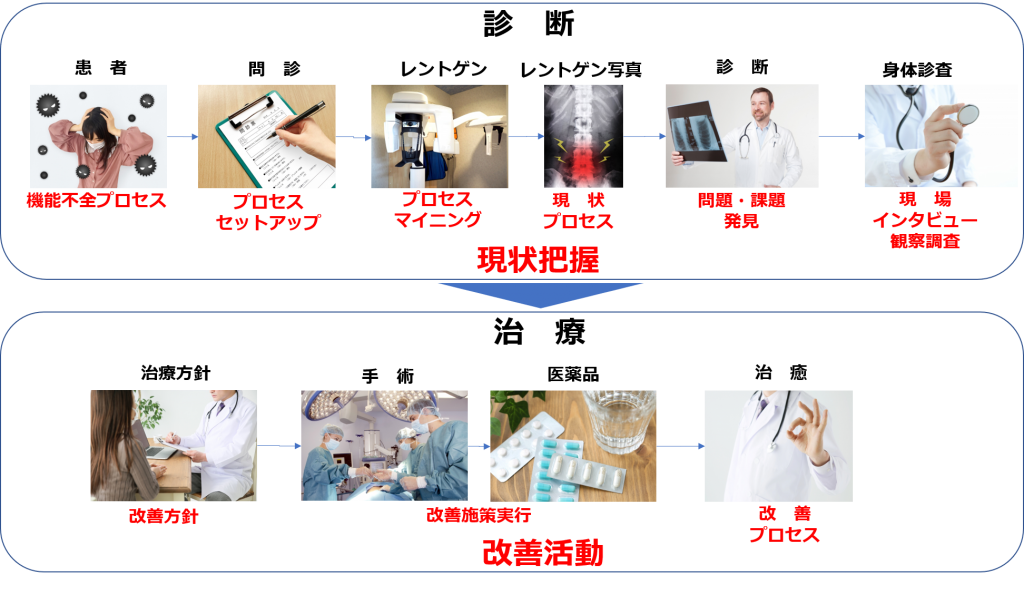How to cure a process with problems
English follows Japanese. Before proofread.
今回は、プロセスマイニングを活用して、ビジネスプロセスを改善する流れを病院での治療の手順と対照させながら説明します。
プロセスマイニングは、イベントログデータから、見えなかったビジネスプロセスを可視化することで、プロセスに潜む様々な課題・問題を発見することを目的としています。
この「プロセスを可視化する」という点から、プロセスマイニングはしばしばX-ray、すなわちレントゲンに例えられます。ただ、病気の治療と同様、病巣(課題・問題)を発見して終わりではなく、適切な治療(改善施策)を施し、健康な状態に戻す、すなわち改善された「理想プロセス」を実現することが最終目的です。
では、まず病院における医療活動の流れを概説しましょう。大きくは、「診断ステージ」と「治療ステージ」の2段階に分けています。
●医療活動
診断ステージ
患 者
発熱、咳などなんらかの症状を抱えた患者の来院が治療の起点となります。
問 診
まずは、現在の症状の程度などについて質問し問診を行います。
レントゲン
X-ray機器を用いて、病巣が存在すると思われる箇所を撮影します。
レントゲン写真
X-ray写真を見ながら、病巣の有無を確認します。
診 断
X-ray写真の結果から、どのような病気に罹患しているか判断します。
身体診査
さらに、さまざまな検査を行い、上記診断結果が正しいかを検証します。
治療ステージ
治療方針
診断結果に基づき、また患者の意向も踏まえて治療方針を行います。たとえば、外科手術を実施するか、薬物治療をどのように行うか、などについてです。
手 術
病巣を除去するほうが良い場合、手術を行います。
医薬品
医薬品だけ、また手術と併せて医薬品を投与して治療を行います。
治 癒
病因が除去され、症状がなくなりました。治療完了です。
次に、上記病院での診断・治療の流れに沿って、ビジネスプロセス改善の手順を概説します。
●ビジネスプロセス改善
現状把握 - 診断ステージ
問題プロセス - 患者
スループットが長い、運営コストが高い、顧客からの苦情が寄せられている、など、なんらかの現象としての問題が発生しているプロセスを改善すべき対象として選択します。
プロセスセットアップ - 問診
プロセスの概要、処理件数、担当部署・担当者など、改善対象プロセスに関わる基本情報を主にインタビューを通じて整理します。プロセスに関わるシステムの仕様書やマニュアルなどがあれば、それらも併せて内容を確認します。
プロセスマイニング - X-ray(レントゲン)
改善対象プロセスのイベントログデータを元にプロセスマイニングツールを用いて分析を行い、現状プロセスのフローチャートを作成します。
現状プロセス - X-ray写真(レントゲン写真)
現状プロセスについて、頻度別、所要時間別など様々な切り口での分析を行います。
問題・課題発見 - 診断
上記分析結果から、現象としての問題・課題を引き起こしている箇所、すなわち、時間がかかりすぎている非効率な手順や、待ち案件が積みあがっているボトルネックなどを特定します。
現場インタビュー・観察 - 身体診査
特定した問題箇所について、現場の担当者に対するインタビューや観察調査などを行い、根本原因の究明を図ります。
プロセスの非効率性やボトルネックを発生させている根本原因としては、あまり意味のない手順が多い、ミスが多く、やり直しをするケースが多い、処理すべき案件にたいしてアサインされている担当者数が少ない、などがあります。
改善活動 - 治療ステージ
改善方針 - 治療方針
プロセスに関わる様々な問題・課題、それらを引き起こしている根本原因が判明したら、改善施策を立案します。
大きな改善方針としてはまず、スループットを短縮する、コストを削減する、顧客満足度を向上する、など目的を明確化することが重要です。
改善施策実行 - 手術・医薬品
改善施策には大掛かりなものからちょっとした修正まで様々な選択肢がありえます。
ゼロベースでプロセスを組みなおすようなBPR(Business Process Re-engineering)は、外科手術にたとえることができるでしょう。マニュアルの業務をRPAのソフトウェアロボットに代替するのは、人工心臓に取り換えるようなものと言えるかもしれません。
ちょっとした手順の変更を行うだけで所要時間が改善できるとしたら、それはシンプルな薬物療法で治療できる病気だったとなるでしょう。
改善プロセス ー 治癒
有効な改善施策を展開した結果、望ましいプロセスが実現できたらひとまずプロジェクト完了です。
病気の治療において、定期検診が必要なように、問題が再発しないか、新たな問題が発生しないか、継続的に対象プロセスを監視することが必要です。
How to cure a process with problems
In this article, I’ll explain the flow of using process mining to improve business processes, contrasting it with the procedure of treatment in a hospital.
Process mining aims to discover various issues and problems hidden in the process by visualizing invisible business processes from the event log data.
In terms of this “visualization of the process”, process mining is often likened to an X-ray. However, just as in the treatment of diseases, the ultimate goal is not the discovery of the lesion (Inefficiencies and bottlenecks) but the implementation of appropriate treatment (improvement measures) and the return to a healthy state, in other words, the realization of an improved “ideal process(to be proess)”.
Let’s start by outlining the flow of medical activities in a hospital. Broadly speaking, there are two stages: the “diagnostic stage” and the “treatment stage”.
●Medical activities
Diagnostic stage
Patient
The starting point for treatment is when a patient comes in with some kind of symptom such as fever or cough.
Preliminary interview
First, we will ask questions about the extent of your current symptoms and conduct an interview.
X-rays
Using an X-ray machine, the area where the lesion is thought to exist will be photographed.
x-ray photograph
The presence of the lesion is confirmed by looking at the X-ray photograph.
Diagnosis
From the results of the X-ray photos, you can determine what diseases the patient have.
Physical examination
In addition, various physical exam and tests will be performed to verify the correctness of the above diagnosis.
●Treatment Stage
Treatment policy
The course of treatment is based on the results of the diagnosis and the patient’s wishes. For example, it’s about whether to carry out surgery or how to treat medication.
Surgery
If it is better to remove the lesion, surgery will be performed.
Medication
The treatment is performed by administering medications alone or in conjunction with surgery.
Recovery
The etiology has been eliminated and the symptoms are gone. Treatment is complete.
Next, we’ll outline the steps to improve business processes along the path of diagnosis and treatment at the above hospital.
●Business Process Improvement
Understanding the current situation – Diagnostic stage
Process with problems – Patient
Select processes that are experiencing problems as phenomena, such as long throughput, high operating costs, customer complaints, etc., as targets for improvement.
Process Setup – Preliminary interview
Basic information related to the process to be improved, such as an overview of the process, the number of processes, and the department or person in charge, will be organized through interviews. If there are any specifications or manuals for the system involved in the process, check them as well.
Process Mining – X-ray
Based on the event log data of the process to be improved, we analyze it using a process mining tool and create a flowchart of the current process.
As is process – X-ray photograph
We analyze the current process from various perspectives, such as frequency and time required.
Problem identification – Diagnosis
Based on the results of the above analysis, we identify the areas that are causing problems or issues as a phenomenon, i.e. inefficient procedures that are taking too long, or bottlenecks that are piling up pending cases.
On-site interview and observation – physical examination
To identify the problem areas, we conduct interviews with the person in charge at the site and conduct observational surveys to identify the root cause.
The root causes of process inefficiencies and bottlenecks are: too many meaningless steps, too many mistakes, too many reworkings, and too few people assigned to deals that need to be done.
Improvement Activities – Treatment Stage
Improvement Policy – Treatment Policy
Once we have identified the various problems and issues related to the process and the root causes of these problems and issues, we plan improvement measures.
As a major improvement policy, it is important to first clarify the objectives, such as reducing throughput, reducing costs, and improving customer satisfaction.
Implementation of improvement measures – Surgery and Medication
There are a variety of options for improvement measures, ranging from major to minor modifications.
BPR (Business Process Re-engineering), which is a zero-based re-engineering of the process, can be compared to surgery. Replacing manual tasks with RPA software robots might be like replacing an artificial heart.
If a small change in procedure could improve the time required, it would be a disease that could be treated with simple medication.
Improved Process (To be process) – Recovery
Once the desired process has been achieved as a result of effective improvement measures, the project is complete.
Just as regular check-ups are necessary in the treatment of a disease, it is important to continuously monitor the target process to ensure that problems do not recur or new problems arise.



